Work has started on Algeria’s 63km bypass motorway to connect Guelma with Annaba and the East-West motorway, which is set to be completed within two years.
Algeria’s Minister for Public Works Abdelkader Kadi made the announcement, has announced the launch of work on the 63km bypass connecting Guelma with Annaba. Nearly $346 million has been set aside for the 35km part of the project within the province of Guelma.
In the province of Annaba, Kadi said that work had started on another section of the mot
December 11, 2014
Read time: 2 mins
Work has started on Algeria’s 63km bypass motorway to connect Guelma with Annaba and the East-West motorway, which is set to be completed within two years.
Algeria’s Minister for Public Works Abdelkader Kadi made the announcement, has announced the launch of work on the 63km bypass connecting Guelma with Annaba. Nearly $346 million has been set aside for the 35km part of the project within the province of Guelma.
In the province of Annaba, Kadi said that work had started on another section of the motorway near the Rabah-Bitat airport. He also announced the opening of the 1.2km Annaba viaduct which cost $254 million.
3260 World Highways %$Linker: 2 Internal <?xml version="1.0" encoding="utf-16"?><dictionary /> 2 19290 0 oLinkExternal reported in November Visit "algerian highway deals being planned" page false /categories/auctions-equipment-supply-servicing-finance/news/algerian-highway-deals-being-planned/ false false %> that the package for the 84km section connecting Annaba with the Tunisian border via the El-Tarf province was allocated to two national groupings. The work was previously being done by the Japanese firm Cojaal.
The Ministry for Public Works said in November that tolling on the East-West Highway will start before the end of 2015. A study is underway to determine how charges can be based on the maintenance and management costs of the link.
Algeria’s Minister for Public Works Abdelkader Kadi made the announcement, has announced the launch of work on the 63km bypass connecting Guelma with Annaba. Nearly $346 million has been set aside for the 35km part of the project within the province of Guelma.
In the province of Annaba, Kadi said that work had started on another section of the motorway near the Rabah-Bitat airport. He also announced the opening of the 1.2km Annaba viaduct which cost $254 million.
The Ministry for Public Works said in November that tolling on the East-West Highway will start before the end of 2015. A study is underway to determine how charges can be based on the maintenance and management costs of the link.







